
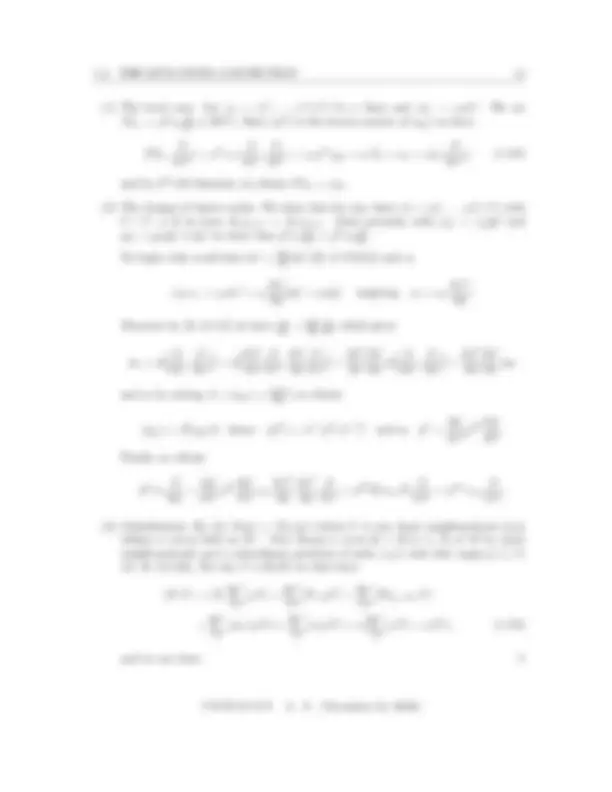
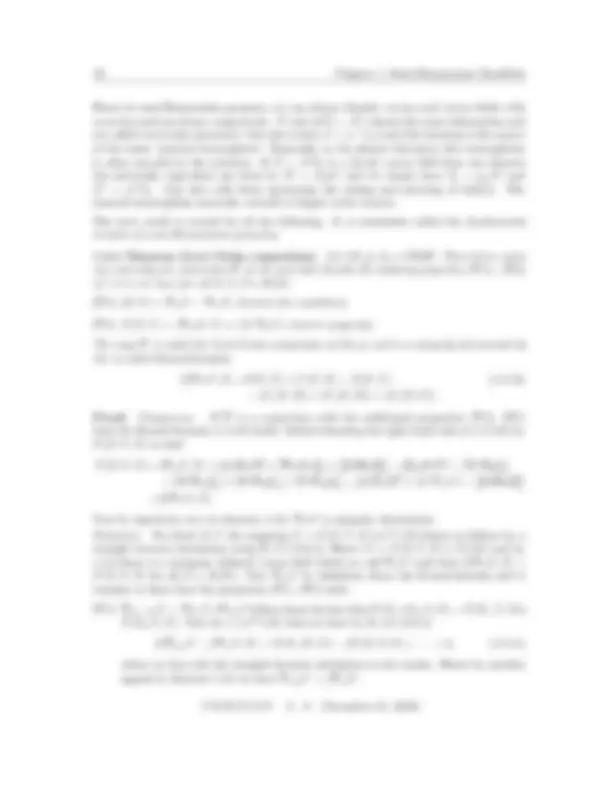
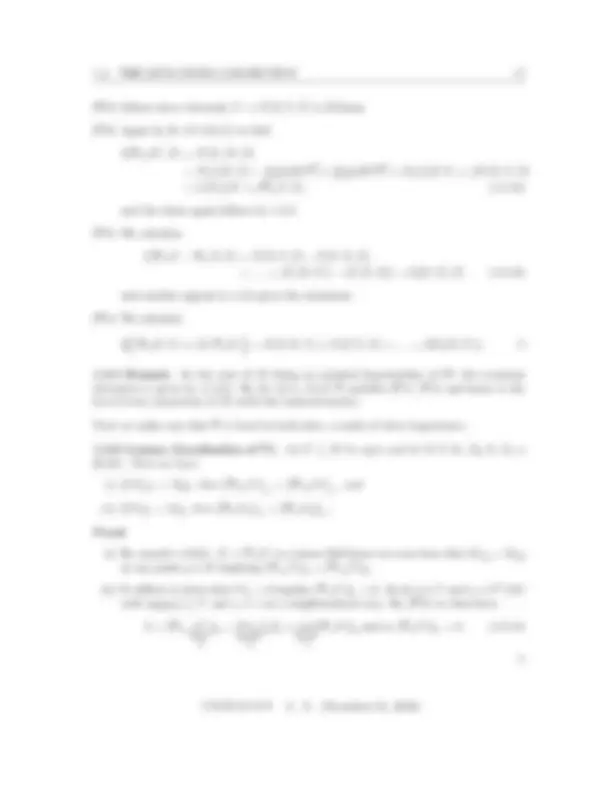
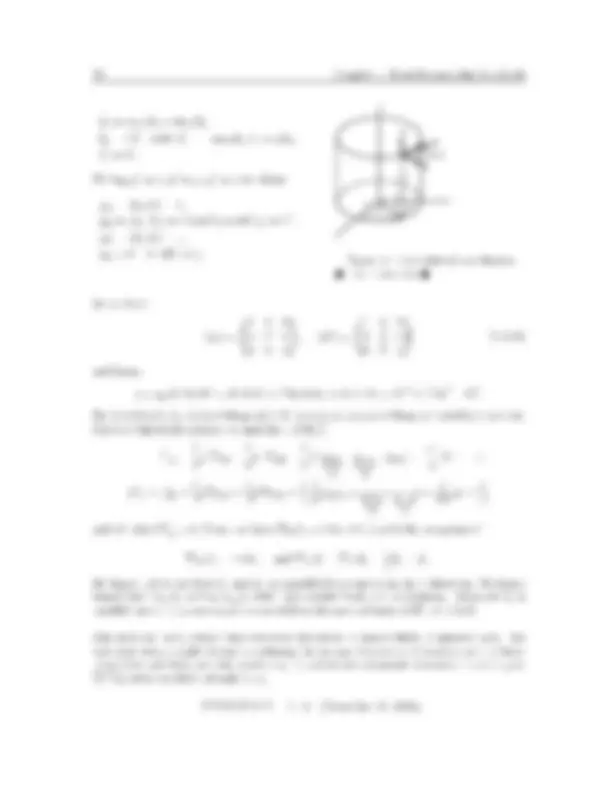
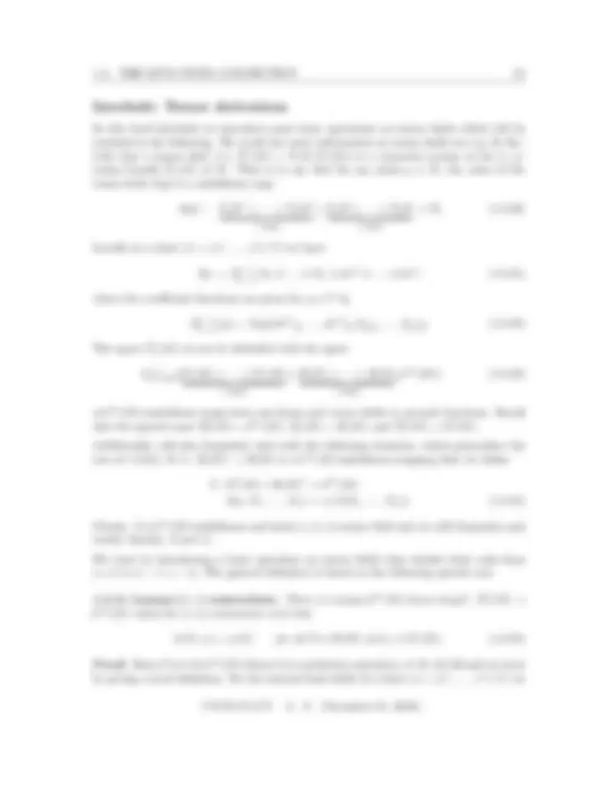
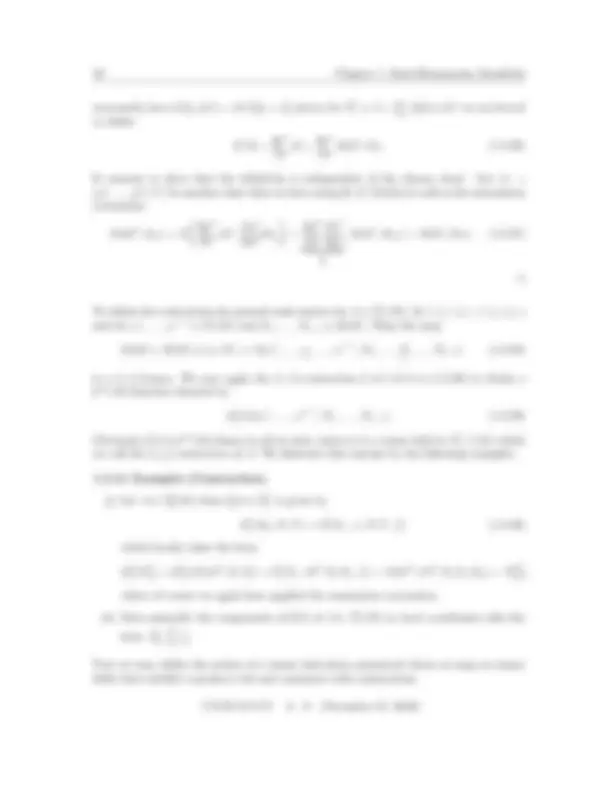
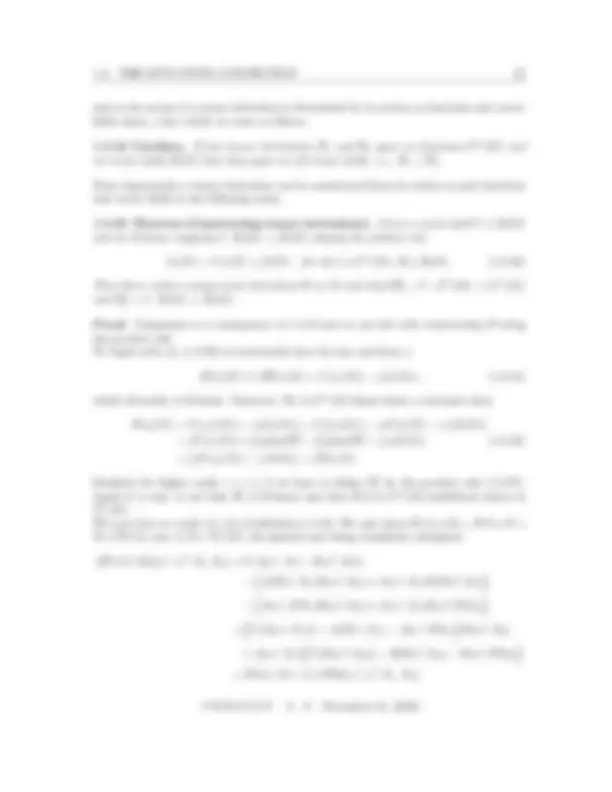
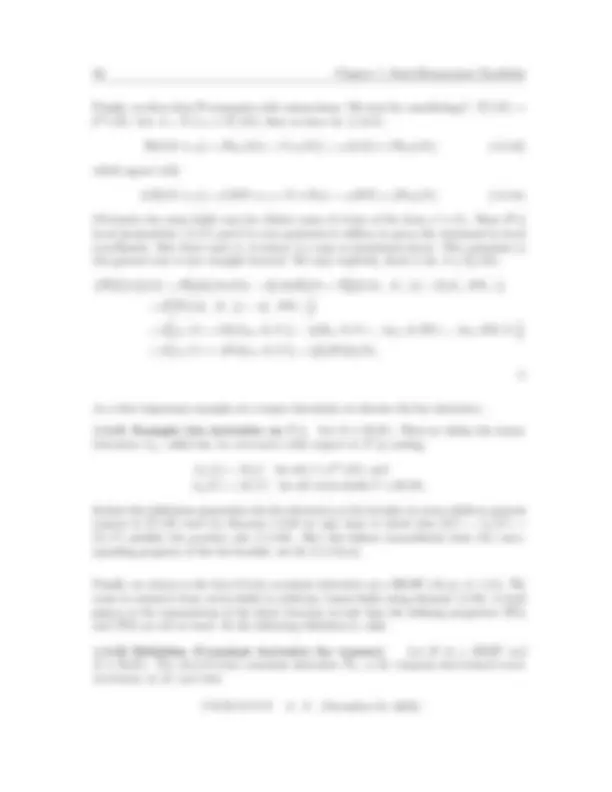
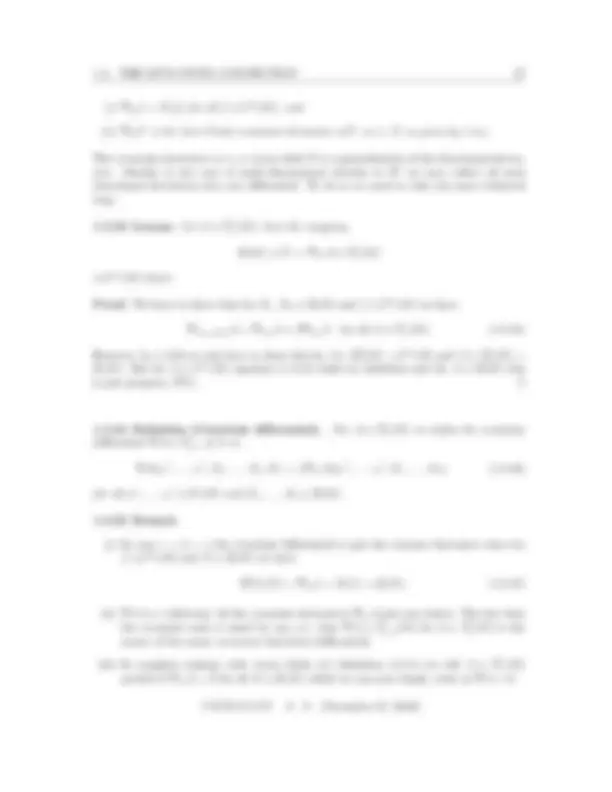


Study with the several resources on Docsity

Earn points by helping other students or get them with a premium plan


Prepare for your exams
Study with the several resources on Docsity

Earn points to download
Earn points by helping other students or get them with a premium plan
Community
Ask the community for help and clear up your study doubts
Discover the best universities in your country according to Docsity users
Free resources
Download our free guides on studying techniques, anxiety management strategies, and thesis advice from Docsity tutors
The concept of covariant derivatives and parallel vector fields in the context of semi-Riemannian manifolds. It covers the definition of covariant derivatives, their properties, and the relationship between covariant derivatives and parallel vector fields. The document also mentions the Levi-Civita connection and the Koszul formula.
What you will learn
Typology: Study notes
1 / 16

This page cannot be seen from the preview
Don't miss anything!










The aim of this chapter is to define on SRMFs a ‘directional derivative’ of a vector field (or more generally a tensor field) in the direction of another vector field. This will be done by generalising the covariant derivative on hypersurfaces of Rn, see [9, Section 3.2] to general SRMFs. Recall that for a hypersurface M in Rn^ and two vector fields X, Y ∈ X(M ) the directional derivative DX Y of Y in direction of X is given by ([9, (3.2.3), (3.2.4)])
DX Y (p) = (DXp Y )(p) = (Xp(Y 1 ),... , Xp(Y n)), (1.3.1)
where Y i^ (1 ≤ i ≤ n) are the components of Y. Although X and Y are supposed to be tangential to M the directional derivative DX Y need not be tangential. To obtain an intrinsic notion one defines on an oriented hypersurface the covariant derivative ∇X Y of Y in direction of X by the tangential projection of the directional derivative, i.e., ([9, 3.2.2])
∇X Y = (DX Y )tan^ = DX Y − 〈DX Y, ν〉 ν, (1.3.2)
where ν is the Gauss map ([9, 3.1.3]) i.e., the unit normal vector field of M such that for all p in the hypersurface det(νp, e^1 ,... , en−^1 ) > 0 for all positively oriented bases {e^1 ,... , en−^1 } of TpM. This construction clearly uses the structure of the ambient Euclidean space, which in case of a general SRMF is no longer available. Hence we will rather follow a different route and define the covariant derivative as an operation that maps a pair of vector fields to another vector field and has a list of characterising properties. Of course these properties are nothing else but the corresponding properties of the covariant derivative on hypersurfaces, that is we turn the analog of [9, 3.2.4] into a definition.
1.3.1 Definition (Connection). A (linear) connection on a C∞-manifold M is a map
∇ : X(M ) × X(M ) → X(M ), (X, Y ) 7 → ∇X Y (1.3.3)
such that the following properties hold
(∇1) ∇X Y is C∞(M )-linear in X (i.e., ∇X 1 +f X 2 Y = ∇X 1 Y + f ∇X 2 Y ∀f ∈ C∞(M ), X 1 , X 2 ∈ X(M )),
(∇2) ∇X Y is R-linear in Y (i.e., ∇X (Y 1 + aY 2 ) = ∇X Y 1 + a∇X Y 2 ∀a ∈ R, Y 1 , Y 2 ∈ X(M )),
(∇3) ∇X (f Y ) = X(f )Y + f ∇X Y for all f ∈ C∞(M ) (Leibniz rule).
We call ∇X Y the covariant derivative of Y in direction X w.r.t. the connection ∇.
14 Chapter 1. Semi-Riemannian Manifolds
1.3.2 Remark (Properties of ∇). (i) Property (∇1) implies that for fixed Y the map X 7 → ∇X Y is a tensor field. This fact needs some explanation. First recall that by [9, 2.6.19] tensor fields are precisely C∞(M )-multilinear maps that take one forms and vector fields to smooth functions, more precisely T (^) sr (M ) ∼= Lr C+∞s(M )(Ω^1 (M ) × · · · × X(M ), C∞(M )). Now for Y ∈ X(M ) fixed, A = X 7 → ∇X Y is a C∞(M )-multininear map A : X(M ) → X(M ) which naturally is identified with the mapping
A¯ : Ω^1 (M ) × X(M ) → C∞(M ), A¯(ω, X) = ω(A(X)) (1.3.4)
which is C∞(M )-multilinear by (∇1), hence a (1, 1) tensor field. Hence we can speak of (∇X Y )(p) for any p in M and moreover given v ∈ TpM we can define ∇vY := (∇X Y )(p), where X is any vector field with Xp = v.
(ii) On the other hand the mapping Y → ∇X Y for fixed X is not a tensor field since (∇3) merely demands R-linearity.
In the following our aim is to show that on any SRMF there is exactly one connection which is compatible with the metric. However, we need a supplementary statement, which is of substantial interest of its own. In any vector space V with scalar product g we have an identification of vectors in V with covectors in V ∗^ via
V ∋ v 7 → v♭^ ∈ V ∗^ where v♭(w) := 〈v, w〉 (w ∈ V ). (1.3.5)
Indeed this mapping is injective by nondegeneracy of g and hence an isomorphism. We will now show that this construction extends to SRMFs providing a identification of vector fields and one forms.
1.3.3 Theorem (Musical isomorphism). Let M be a SRMF. For any X ∈ X(M ) define X♭^ ∈ Ω^1 (M ) via X♭(Y ) := 〈X, Y 〉 ∀Y ∈ X(M ). (1.3.6)
Then the mapping X 7 → X♭^ is a C∞(M )-linear isomorphism from X(M ) to Ω^1 (M ).
Proof. First X♭^ : X(M ) → C∞(M ) is obviously C∞(M )-linear, hence in Ω^1 (M ), cf. [9, 2.6.19]. Also the mapping φ : X 7 → X♭^ is C∞(M )-linear and we show that it is an isomorphism.
φ is injective: Let φ(X) = 0, i.e., 〈X, Y 〉 = 0 for all Y ∈ X(M ) implying 〈Xp, Yp〉 = 0 for all Y ∈ X(M ), p ∈ M. Now let v ∈ TpM and choose a vector field Y ∈ X(M ) with Yp = v. But then by nondegeneracy of g(p) we obtain
〈Xp, v〉 = 0 ⇒ Xp = 0, (1.3.7)
and since p was arbitrary we infer X=0.
φ is surjective: Let ω ∈ Ω^1 (M ). We will construct X ∈ X(M ) such that φ(X) = ω. We do so in three steps.
16 Chapter 1. Semi-Riemannian Manifolds
Hence in semi-Riemannian geometry we can always identify vectors and vector fields with covectors and one forms, respectively: X and φ(X) = X♭^ contain the same information and are called metrically equivalent. One also writes ω♯^ = φ−^1 (ω) and this notation is the source of the name ‘musical isomorphism’. Especially in the physics literature this isomorphism is often encoded in the notation. If X = Xi∂i is a (local) vector field then one denotes the metrically equivalent one form by X♭^ = Xidxi^ and we clearly have Xi = gij Xj^ and Xi^ = gij^ Xj. One also calls these operations the raising and lowering of indices. The musical isomorphism naturally extends to higher order tensors. The next result is crucial for all the following. It is sometimes called the fundamental Lemma of semi-Riemannian geometry.
1.3.4 Theorem (Levi Civita connection). Let (M, g) be a SRMF. Then there exists one and only one connection ∇ on M such that (besides the defining properties (∇1)−(∇3) of 1.3.1) we have for all X, Y, Z ∈ X(M )
(∇4) [X, Y ] = ∇X Y − ∇Y X (torsion free condition)
(∇5) Z〈X, Y 〉 = 〈∇Z X, Y 〉 + 〈X, ∇Z Y 〉 (metric property).
The map ∇ is called the Levi-Civita connection of (M, g) and it is uniquely determined by the so-called Koszul-formula 2 〈∇X Y, Z〉 =X〈Y, Z〉 + Y 〈Z, X〉 − Z〈X, Y 〉 (1.3.10) − 〈X, [Y, Z]〉 + 〈Y, [Z, X]〉 + 〈Z, [X, Y ]〉.
Proof. Uniqueness: If ∇ is a connection with the additional properties (∇4), (∇5) then the Koszul-formula (1.3.10) holds: Indeed denoting the right hand side of (1.3.10) by F (X, Y, Z) we find F (X, Y, Z) =〈∇X Y, Z〉 + (^) ✘✘✘✘✘ ✘ 〈Y, ∇X Z〉 + ❳❳❳ 〈∇Y Z, X❳❳❳〉 + (^) ✘✘✘✘✘ ❳❳❳ ✘ 〈Z, ∇Y❳❳ X❳〉 − (^) ✘✘✘✘✘ ✘ 〈∇Z X, Y 〉 − ❳❳❳ 〈X, ∇❳❳Z Y❳ 〉 − ❳〈X,❳❳ ∇❳Y Z❳❳〉 + ❳〈X,❳❳ ∇❳Z Y❳❳ 〉 + ❳〈Y,❳ ∇❳❳Z X❳❳〉 − (^) ✘✘ 〈Y, ∇✘X✘✘ Z✘〉 + 〈Z, ∇X Y 〉 − (^) ✘❳〈Z,✘❳ ∇✘✘❳❳Y X✘❳✘❳〉 =2〈∇X Y, Z〉. Now by injectivity of φ in theorem 1.3.3, ∇X Y is uniquely determined. Existence: For fixed X, Y the mapping Z 7 → F (X, Y, Z) is C∞(M )-linear as follows by a straight forward calculation using [9, 2.5.15(iv)]. Hence Z 7 → F (X, Y, Z) ∈ Ω^1 (M ) and by 1.3.3 there is a (uniquely defined) vector field which we call ∇X Y such that 2〈∇X Y, Z〉 = F (X, Y, Z) for all Z ∈ X(M ). Now ∇X Y by definition obeys the Koszul-formula and it remains to show that the properties (∇1)–(∇5) hold.
(∇1) ∇X 1 +X 2 Y = ∇X 1 Y +∇X 2 Y follows from the fact that F (X 1 +X 2 , Y, Z) = F (X 1 , Y, Z)+ F (X 2 , Y, Z). Now let f ∈ C∞(M ) then we have by [9, 2.5.15(iv)] 2 〈∇f X Y − f ∇X Y, Z〉 = F (X, f Y, Z) − f F (X, Y, Z) =... = 0, (1.3.11) where we have left the straight forward calculation to the reader. Hence by another appeal to theorem 1.3.3 we have ∇f X Y = f ∇X Y.
(∇2) follows since obviously Y 7 → F (X, Y, Z) is R-linear.
(∇3) Again by [9, 2.5.15(iv)] we find
2 〈∇X f Y , Z〉 = F (X, f Y, Z) = X(f )〈Y, Z〉 − (^) ✘✘✘✘✘✘
✘ Z(f )〈X, Y 〉 + (^) ✘✘✘✘✘✘
✘ Z(f )〈X, Y 〉 + X(f )〈Z, Y 〉 + f F (X, Y, Z) = 2 〈X(f )Y + f ∇X Y, Z〉, (1.3.12)
and the claim again follows by 1.3.3.
(∇4) We calculate
2 〈∇X Y − ∇Y X, Z〉 = F (X, Y, Z) − F (Y, X, Z) =... = 〈Z, [X, Y ]〉 − 〈Z, [Y, X]〉 = 2〈[X, Y ], Z〉 (1.3.13)
and onother appeal to 1.3.3 gives the statement.
(∇5) We calculate
2
1.3.5 Remark. In the case of M being an oriented hypersurface of Rn^ the covariant derivative is given by (1.3.2). By [9, 3.2.4, 3.2.5] ∇ satisfies (∇1)–(∇5) and hence is the Levi-Civita connection of M (with the induced metric).
Next we make sure that ∇ is local in both slots, a result of utter importance.
1.3.6 Lemma (Localisation of ∇). Let U ⊆ M be open and let X, Y, X 1 , X 2 , Y 1 , Y 2 ∈ X(M ). Then we have (i) If X 1 |U = X 2 |U then
U , and (ii) If Y 1 |U = Y 2 |U then
Proof. (i) By remark 1.3.2(i): X 7 → ∇X Y is a tensor field hence we even have that X 1 |p = X 2 |p at any point p ∈ M implying (∇X 1 Y )|p = (∇X 2 Y )|p.
(ii) It suffices to show that Y |U = 0 implies (∇X Y )|U = 0. So let p ∈ U and χ ∈ C∞(M ) with supp(χ) ⊆ U and χ ≡ 1 on a neighbourhood of p. By (∇3) we then have
)|p = X(χ) ︸ ︷︷ ︸ =
|pYp + χ(p) ︸︷︷︸ =
(∇X Y )|p and so (∇X Y )|U = 0. (1.3.14)
1.3.10 Lemma (The connection of flat space). For X, Y ∈ X(Rnr ) with Y = (Y 1 ,... , Y n) = Y i∂i let
∇X Y = X(Y i)∂i. (1.3.17)
Then ∇ is the Levi-Civita connection on Rnr and in natural coordinates (i.e., using id as a global chart) we have
(i) gij = δij εj (with εj = − 1 for 1 ≤ j ≤ r and εj = +1 for r < j ≤ n),
(ii) Γijk = 0 for all 1 ≤ i, j, k ≤ n.
Proof. Recall that in the terminology of [9, Sec. 3.2] we have ∇X Y = DX Y = p 7 → DY (p) Xp which coincides with (1.3.17). The validity of (∇1)–(∇5) has been checked in [9, 3.2.4,5] and hence ∇ is the Levi-Civita connection. Moreover we have
(i) gij = 〈∂i, ∂j 〉 = 〈ei, ej 〉 = εiδij , and
(ii) Γijk = 0 by (i) and 1.3.9(i). ✷
Next we consider vector fields with vanishing covariant derivatives.
1.3.11 Definition (Parallel vector field). A vector field X on a SRMF M is called parallel if ∇Y X = 0 for all Y ∈ X(M ).
1.3.12 Example. The coordinate vector fields in Rnr are parallel: Let Y = Y j^ ∂j then by 1.3.10(ii) ∇Y ∂i = Y j^ ∇∂j ∂i = 0. More generally on Rnr the constant vector fields are precisely the parallel ones, since
∇Y X = 0 ∀Y ⇔ DX(p)Y (p) = 0 ∀Y ∀p ⇔ DX = 0 ⇔ X = const. (1.3.18)
In light of this example the notion of a parallel vector field generalises the notion of a constant vector field. We now present an explicit example.
1.3.13 Example (Cylindrical coordinates on R^3 ). Let (r, ϕ, z) be cylindrical coor- dinates on R^3 , i.e., (x, y, z) = (r cos ϕ, r sin ϕ, z), see figure 1.4. This clearly is a chart on R^3 \ {x ≥ 0 , y = 0}. Its inverse (r, ϕ, z) 7 → (r cos ϕ, r sin ϕ, z) is a parametrisation, hence we have (cf. [9, below 2.4.11] or directly [9, 2.4.15])
22 Chapter 1. Semi-Riemannian Manifolds
necessarily have C(∂j , dxi) = dxi(∂j ) = δji and so for T 11 ∋ A =
Aij ∂i ⊗ dxj^ we are forced to define
C(A) =
i
Aii =
i
A(dxi, ∂j ). (1.3.26)
It remains to show that the definition is independent of the chosen chart. Let (ψ = (y^1 ,... , yn), V ) be another chart then we have using [9, 2.7.27(iii)] as well as the summation convention
A(dym, ∂m) = A
∂ym ∂xi^
dxi, ∂xj ∂ym^
∂xj
∂ym ∂xi
∂xj ︸ ︷︷^ ∂y m︸ δji
A(dxi, ∂xj ) = A(dxi, ∂xi). (1.3.27)
To define the contraction for general rank tensors let A ∈ T (^) sr (M ), fix 1 ≤ i ≤ r, 1 ≤ j ≤ s and let ω^1 ,... , ωr−^1 ∈ Ω^1 (M ) and X 1 ,... , Xs− 1 ∈ X(M ). Then the map
Ω(M ) × X(M ) ∋ (ω, X) 7 → A(ω^1 ,... , ω i ,... , ωr−^1 , X 1 ,... , X j ,... , Xs− 1 ) (1.3.28)
is a (1, 1)-tensor. We now apply the (1, 1)-contraction C of 1.3.14 to (1.3.28) to obtain a C∞(M )-function denoted by
(Cji A)(ω^1 ,... , ωn−^1 , X 1 ,... , Xs− 1 ). (1.3.29)
Obviously Cji A is C∞(M )-linear in all its slots, hence it is a tensor field in T (^) sr−− 11 (M ) which we call the (i, j)-contraction of A. We illustrate this concept by the following examples.
1.3.15 Examples (Contraction).
(i) Let A ∈ T 32 (M ) then C 31 A ∈ T 21 is given by
C 31 A(ω, X, Y ) = C
A(. , ω, X, Y, .)
which locally takes the form
(C 31 A)kij = (C^13 (A)(dxk, ∂i, ∂j ) = C
A(. , dxk, ∂i, ∂j , .)
= A(dxm, dxk, ∂i, ∂j , ∂m) = Amkijm,
where of course we again have applied the summation convention.
(ii) More generally the components of Clk A of A ∈ T (^) sr (M ) in local coordinates take the form Ai^1 ...^ m...ik r j 1 ...m l ...js.
Now we may define the notion of a tensor derivation announced above as map on tensor fields that satisfies a product rule and commutes with contractions.
1.3.16 Definition (Tensor derivation). A tensor derivation D on a smooth manifold M is a family of R-linear maps
D = Drs : T (^) sr (M ) → T (^) sr (M ) (r, s ≥ 0) (1.3.31)
such that for any pair A, B of tensor fields we have
(i) D(A ⊗ B) = DA ⊗ B + A ⊗ DB
(ii) D(CA) = C(DA)) for any contraction C.
The product rule in the special case f ∈ C∞(M ) = T 00 (M ) and A ∈ T (^) sr (M ) takes the form
D(f ⊗ A) = D(f A) = (Df )A + f DA. (1.3.32)
Moreover for r = 0 = s the tensor derivation D 00 is a derivation on C∞(M ) (cf. [9, 2.5.12]) and so by [9, 2.5.13] there exists a unique vector field X ∈ X(M ) such that
Df = X(f ) for all f ∈ C∞(M ). (1.3.33)
Despite the fact that tensor derivations are not C∞(M )-linear and hence not pointwise defined^2 (cf. [9, 2.6.19]) they are local operators in the following sense.
1.3.17 Proposition (Tensor derivations are local). Let D be a tensor derivation on M and let U ⊆ M be open. Then there exists a unique tensor derivation DU on U , called the restriction of D to U statisfying
DU (A|U ) = (DA)|U (1.3.34)
for all tensor fields A on M.
Proof. Let B ∈ T (^) sr (U ) and p ∈ U. Choose a cut-off function χ ∈ C 0 ∞ (U ) with χ ≡ 1 in a neighbourhood of p. Then χB ∈ T (^) sr (M ) and we define
(DU B)(p) := D(χB)(p). (1.3.35)
We have to check that this definition is valid and leads to the asserted properties.
(1) The definition is independent of χ: choose another cut-off function ˜χ at p and set f = χ − χ˜. Then choosing a function ϕ ∈ C∞ 0 (U ) with ϕ ≡ 1 on supp(f ) we obtain
D(f B)(p) = D(f ϕB)(p) = D(f )|p(ϕB)(p) + f (p) ︸︷︷︸ =
D(ϕB)(p) = 0, (1.3.36)
since we have with a vector field X as in (1.3.33) that Df (p) = X(f )(p) = 0 by the fact that f ≡ 0 near the point p. (^2) Recall from analysis that taking a derivative of a function is not a pointwise operation: It depends on the values of the function in a neighbourhood.
and so the action of a tensor derivation is determined by its action on functions and vector fields alone, a fact which we state as follows.
1.3.19 Corollary. If two tensor derivations D 1 and D 2 agree on functions C∞(M ) and on vector fields X(M ) then they agree on all tensor fields, i.e., D 1 = D 2.
More importantly a tensor derivation can be constructed from its action on just functions and vector fields in the following sense.
1.3.20 Theorem (Constructing tensor derivations). Given a vector field V ∈ X(M ) and an R-linear mapping δ : X(M ) → X(M ) obeying the product rule
δ(f X) = V (f )X + f δ(X) for all f ∈ C∞(M ), X ∈ X(M ). (1.3.40)
Then there exists a unique tesor derivation D on M such that D^00 = V : C∞(M ) → C∞(M ) and D 01 = δ : X(M ) → X(M ).
Proof. Uniqueness is a consequence of 1.3.19 and we are left with constructing D using the product rule. To begin with, by (1.3.39) we necessarily have for any one-form ω
(Dω)(X) ≡ (D 10 ω)(X) = V (ω(X)) − ω(δ(X)), (1.3.41)
which obviously is R-linear. Moreover, Dω is C∞(M )-linear hence a one-form since
Dω(f X) = V (ω(f X)) − ω(δ(f X)) = V (f ω(X)) − ω(V (f )X) − ω(f δ(X)) = f V (ω(X)) + (^) ✘✘✘✘✘ ✘ V (f )ω(X) − (^) ✘✘✘✘✘ ✘ V (f )ω(X) − f ω(δ(X)) (1.3.42) = f
V (ω(X)) − ω(δ(X)
= f Dω(X).
Similarly for higher ranks r + s ≥ 2 we have to define Dsr by the product rule (1.3.37): Again it is easy to see that Drs is R-linear and that Drs A is C∞(M )-multilinear hence in T (^) sr (M ). We now have to verify (i), (ii) of definition 1.3.16. We only show D(A ⊗ B) = DA ⊗ B + B ⊗ DA in case A, B ∈ T 11 (M ), the general case being completely analogous: ( D(A ⊗ B)
(ω^1 , ω^2 , X 1 , X 2 ) = V (A(ω^1 , X 1 ) · B(ω^2 , X 2 )) −
A(Dω^1 , X 1 )B(ω^2 , X 2 ) + A(ω^1 , X 1 )B(Dω^2 , X 2 )
A(ω^1 , DX 1 )B(ω^2 , X 2 ) + A(ω^1 , X 1 )B(ω^2 , DX 2 )
A(ω^1 , X 1 )
− A(Dω^1 , X 1 ) − A(ω^1 , DX 1 )
B(ω^2 , X 2 )
B(ω^2 , X 2 )
− B(Dω^2 , X 2 ) − B(ω^2 , DX 2 )
= (DA ⊗ B + A ⊗ DB)(ω^1 , ω^2 , X 1 , X 2 ).
26 Chapter 1. Semi-Riemannian Manifolds
Finally, we show that D commutes with contractions. We start by considering C : T 11 (M ) → C∞(M ). Let A = X ⊗ ω ∈ T 11 (M ), then we have by (1.3.41)
D(C(X ⊗ ω)) = D(ω(X)) = V (ω(X)) = ω(δ(X)) + D(ω)(X), (1.3.43)
which agrees with
C(D(X ⊗ ω)) = C(DX ⊗ ω + X ⊗ Dω) = ω(DX) + (Dω)(X). (1.3.44)
Obviously the same holds true for (finite) sums of terms of the form ωi^ ⊗ Xi. Since D is local (proposition 1.3.17) and C is even pointwise it suffices to prove the statement in local coordinates. But there each (1, 1)-tensor is a sum as mentioned above. The extension to the general case is now straight forward. We only explicitly check it for A ∈ T 21 (M ):
( D 10 (C 21 A)
(ω, Y ) 7 → D
A(ω, X, Y )
− A(Dω, X, Y ) − A(ω, X, DY ) − A(ω, DX, Y )
(ω, Y ) 7 → (DA)(ω, X, Y )
As a first important example of a tensor derivation we discuss the Lie derivative.
1.3.21 Example (Lie derivative on T (^) sr ). Let X ∈ X(M ). Then we define the tensor derivative LX , called the Lie derivative with respect to X by setting
LX (f ) = X(f ) for all f ∈ C∞(M ), and LX (Y ) = [X, Y ] for all vector fields Y ∈ X(M ).
Indeed this definition generalises the Lie derivative or Lie bracket of vector fields to general tensors in T (^) sr (M ) since by theorem 1.3.20 we only have to check that δ(Y ) = LX (Y ) = [X, Y ] satisfies the product rule (1.3.40). But this follows immediately form the corre- sponding property of the Lie bracket, see [9, 2.5.15(iv)].
Finally we return to the Levi-Civita covariant derivative on a SRMF (M, g), cf. 1.3.4. We want to extend it from vector fields to arbitrary tensor fields using theorem 1.3.20. A brief glance at the assumptions of the latter theorem reveals that the defining properties (∇2) and (∇3) are all we need. So the following definition is valid.
1.3.22 Definition (Covariant derivative for tensors). Let M be a SRMF and X ∈ X(M ). The (Levi-Civita) covariant derivative ∇X is the uniquely determined tensor derivation on M such that
28 Chapter 1. Semi-Riemannian Manifolds
(iv) The metric condition (∇5) just says that g itself is parallel since by the product rule 1.3.18 we have for all X, Y , Z ∈ X(M )
(∇Z g)(X, Y ) = ∇Z (g(X, Y )) − g(∇Z X, Y ) − g(X, ∇Z ,Y ) (1.3.48)
which vanishes by (∇5).
(v) If in a local chart the tensor field A ∈ T (^) sr (M ) has components Ai j^11 ...i...jrs the components of its covariant differential ∇A ∈ T (^) sr+1(M ) are denoted by Ai j^11 ...i...jrs;k and take the form
Ai j^11 ...i...jrs;k =
∂Ai j^11 ...i...jrs ∂xk^
∑^ r
l=
Γi kml Ai j^11 ...m...i.........jrs −
∑^ s
l=
Γmkjl Ai j^11 .........i...m...jrs. (1.3.49)
Our next topic is the notion of a covariant derivative of vector fields which are not defined on all of M but just, say on (the image of) a curve. Of course then we can only expect to be able to define a derivative of the vector field in the direction of the curve. Intuitively such a notion corresponds to the rate of change of the vector field as we go along the curve. We begin by making precise the notion of such vector fields but do not restrict ourselves to the case of curves.
1.3.26 Definition (Vector field along a mapping). Let N, M be smooth manifolds and let f ∈ C∞(N, M ). A vector field along f is a smooth mapping
Z : N → T M such that π ◦ Z = f, (1.3.50)
where π : T M → M is the vector bundle projection. We denote the C∞(N )-module of all vector fields along f by X(f ).
The definition hence says that Z(p) ∈ Tf (p)M for all points p ∈ N. In the special case of N = I ⊆ R a real interval and f = c : I → M a C∞-curve we call X(c) the space of vector fields along the curve c. In particular, in this case t 7 → c˙(t) ≡ c′(t) ∈ X(c). More precisely we have (cf. [9, below (2.5.3)]) c′(t) = Ttc(1) = Ttc( (^) ∂t∂ |t) ∈ Tc(t)M. Also recall for later use that for any f ∈ C∞(M ) we have c′(t)(f ) = Ttc( (^) dtd |t)(f ) = (^) dtd |t(f ◦ c) and consequently in coordinates ϕ = (x^1 ,... , xn) the local expression of the velocity vector takes the form c′(t) = c′(t)(xi)∂i|c(t) = (^) dtd |t(xi^ ◦ c)∂i|c(t). (For more details see e.g. [11, 1.17 and below].) In case M is a SRMF we may use the Levi-Civita covariant derivative to define the deriva- tive Z′^ of Z ∈ X(c) along the curve c.
1.3.27 Proposition (Induced covariant derivative). Let c : I → M be a smooth curve into the SRMF M. Then there exists a unique mapping X(c) → X(c)
dt
called the induced covariant derivative such that